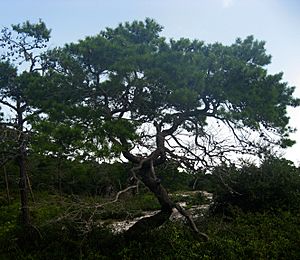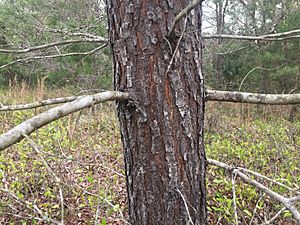Pinus clausa facts for kids
Quick facts for kids Pinus clausa |
|
|---|---|
 |
|
| Conservation status | |
| Scientific classification | |
| Genus: |
Pinus
|
| Species: |
clausa
|
 |
|
| Generalized natural range of Pinus clausa | |
Pinus clausa is a special type of pine tree that grows only in the southeastern United States. You might know it by its common names like sand pine, Florida spruce pine, or scrub pine. This tree is very important to the sandy, sunny areas where it lives.
Contents
Where Sand Pines Grow
Sand pines are found in two main areas. One is in central Florida, and the other stretches along the western Florida coast into Alabama. There's a gap of about 200 kilometers (124 miles) between these two groups of trees.
These trees mostly grow in very poor, sandy soils. The soil drains water quickly, and the sun is often hot. These tough conditions mean that not many other big trees can grow there. This helps the sand pine, as it faces less competition. Often, it's the only tall tree you'll see in the Florida scrub ecosystem.
What Sand Pines Look Like
The Pinus clausa is usually a small tree, often looking more like a shrub. It typically grows about 5 to 10 meters (16 to 33 feet) tall. Some can grow taller, up to 21 meters (69 feet).
Its leaves are like needles, and they grow in pairs. Each needle is about 5 to 10 centimeters (2 to 4 inches) long. The tree's cones are about 3 to 8 centimeters (1 to 3 inches) long.
How Sand Pines Reproduce with Fire
Many sand pines have a special way of reproducing. Their cones stay tightly closed for many years. This is why the tree is called clausa, which means "closed."
These cones only open when there's a natural wildfire. The fire kills the older trees, but the heat makes the cones open. This releases the seeds onto the burnt ground, allowing new sand pines to grow. Some sand pine groups have cones that open on their own without fire.
Why Sand Pines Are Important
Pinus clausa woodlands are a key part of the Florida scrub ecosystem. They provide a home for many animals, including the endangered Florida sand skink. This tree is one of the few that can grow well in dry, sandy, and hot places without much care.
Even though its branches grow very close together, making it hard to use for solid wood, sand pine is often used to make wood pulp. This pulp is then used to make paper and other products.
See also
 In Spanish: Pinus clausa para niños
In Spanish: Pinus clausa para niños



